#museum of fine arts of rennes
Text

Charles-André van Loo (1705-1765)
"Portrait of Innocente Guillemette de Rosnyvinen de Piré" (c. 1762)
Oil on canvas
Located in the Musée des beaux-arts de Rennes, Rennes, France
#paintings#art#artwork#genre painting#female portrait#charles andré van loo#charles andre van loo#oil on canvas#fine art#musée des beaux arts de rennes#musee des beaux arts de rennes#museum of fine arts of rennes#art gallery#french artist#portrait of a woman#gray dress#grey#dresses#clothing#clothes#melancholy#melancholic#melancholia#sad#sadness#sad eyes#1760s#mid 1700s#mid 18th century#blue
72 notes
·
View notes
Text
Last night was my company Holiday Party, and we're doing really well, so it was held at the Museum of Fine Arts (Boston)
I was so happy that also included the Styled by Sargent exhibit, of John Singer Sargent paintings and the actual articles of clothing alongside them.
Now, you have probably seen this painting of Lady Macbeth

But have you seen the costume she's wearing??

It's gorgeous, obviously.
But that texture! It's *crochet*
And some knitting
Really simple crochet too; just a chain and single crochet lattice with beads and metallic thread added for this chain mail effect.
Despite John Singer Sargent being an expert painter of fabric (no, really, just look at it), I never knew Lady Macbeth's costume had to be *hand crocheted* for that texture in the painting.
Anyway I'm gonna be making myself some faux-chainmail by crocheting it for the next Renn Faire
#art#not my art#john singer sargent#lady macbeth#costume#costuming#shakespeare#macbeth#crochet#knitting#painting#fabric
10K notes
·
View notes
Photo
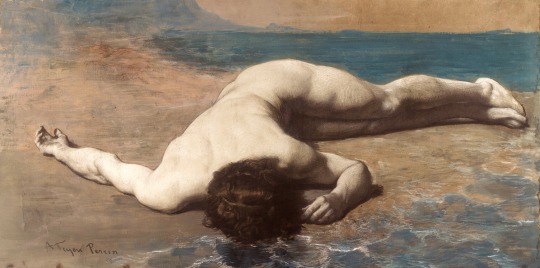
François Nicolas Feyen-Perrin, (1826-1888), After the Storm, before 1865, pastel on paper laid down on canvas. Rennes Museum of Fine Arts. http://hadrian6.tumblr.com
2K notes
·
View notes
Text

Léon Cogniet, Scene of the Massacre of the Innocents, 1824, oil on canvas, 261.3 x 228.3 cm, Museum of Fine Arts of Rennes, Rennes, France.
Today is Holy Innocents' Day, recalling the massacre ordered by Herod. So, I wanted to share this painting, cause it's such a unique take on the famous art history theme "The Massacre of the Innocents."
The paintings that I was used to seeing depicted the actual massacre. There are babies being murdered, and mothers screaming and begging, like the ones by Rubens (left) and Reni (right).
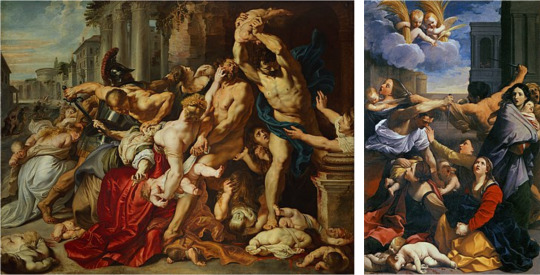
But this one offers another pov. Here is a mother hiding from the chaos as she covers her son's mouth so that they don't hear them. But she's looking at us terrified as if she fears that we are going to tell the soldiers about them.
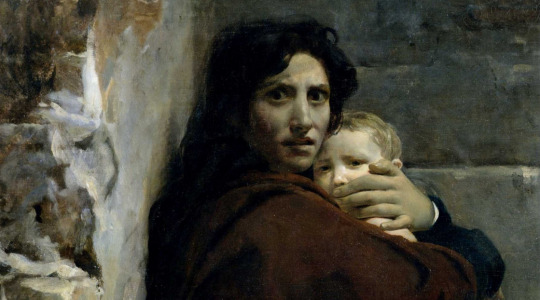
It's terrifying.
2 notes
·
View notes
Photo
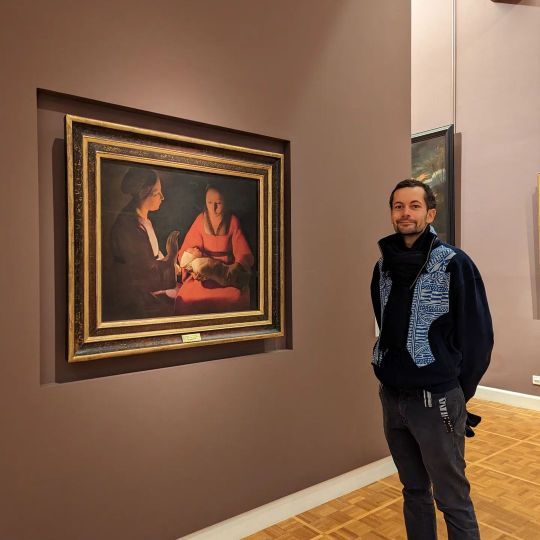
Conserved at the Museum of Fine Arts in #rennes, The Newborn is a painting by the Lorraine painter Georges de La Tour dated from 1645-1648. This oil on canvas represents the Virgin Mary holding the swaddled Child Jesus, in the company of Saint Anne who lights the scene with a candle. The Newborn is one of the most important works of Georges de La Tour due to the quality of the painting itself. This is not a simple maternity scene, but a religious subject featuring the Virgin, her mother Saint Anne and the Child Jesus. The painting had entered the collections of the Musée des Beaux-Arts in Rennes in 1794 thanks to the revolutionary seizures of the property of emigrants. It was then attributed to a Dutch painter, Godfried Schalken. Later, it was considered a work of the Le Nain Brothers, an attribution still in force when the German art critic Hermann Voss returned the canvas to Georges de La Tour. Inspired meeting, the pleasure of sitting on the bench in front of the famous painting and lingering over details such as the light of the candle reflected on the fingernails of the Virgin Mary, the softness of the faces, the beauty emanating from this moment of peaceful #intimacy … #art #virginmary #jesus (à Musée des Beaux-Arts de Rennes) https://www.instagram.com/p/Co-xpGILmlC/?igshid=NGJjMDIxMWI=
0 notes
Photo
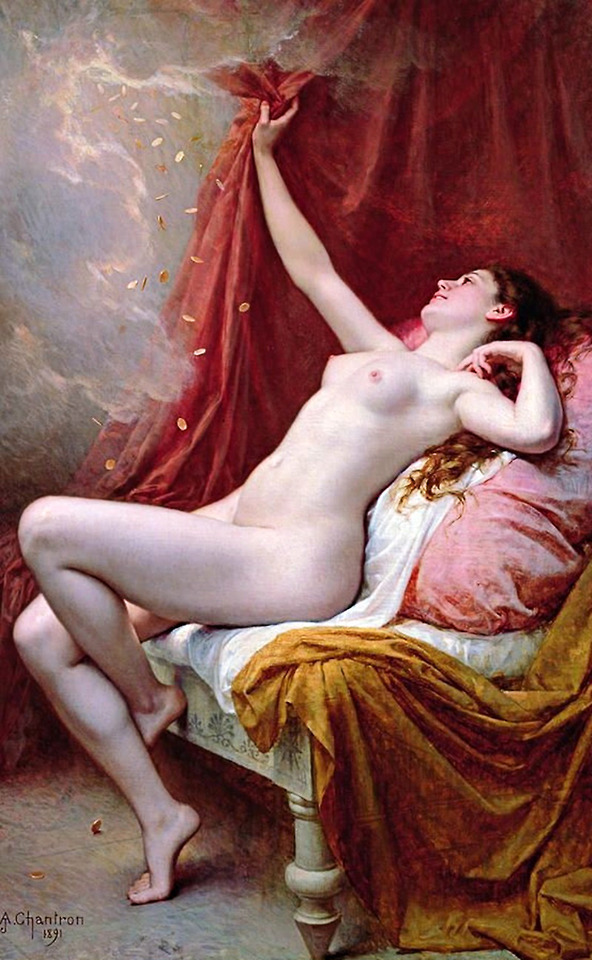
Danaë, Alexandre-Jacques Chantron, 1891
#art#art history#Alexandre-Jacques Chantron#classical mythology#mythological painting#Danae#odalisque#nude in art#Academicism#Academic art#French art#19th century art#Museum of Fine Arts of Rennes#Musee des beaux-arts de Rennes
879 notes
·
View notes
Text
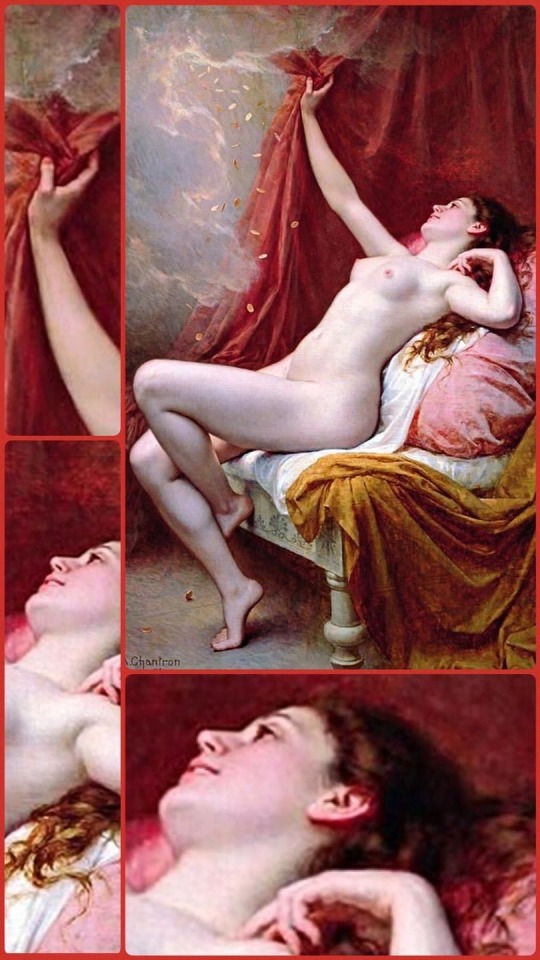
Alexandre-Jacques Chantron (French; 1842 - 1918) ”Danae”, 1891, Oil on canvas, 173 x 116.5 cm, Collage, Museum of Fine Arts of Rennes, Rennes, France
8 notes
·
View notes
Text
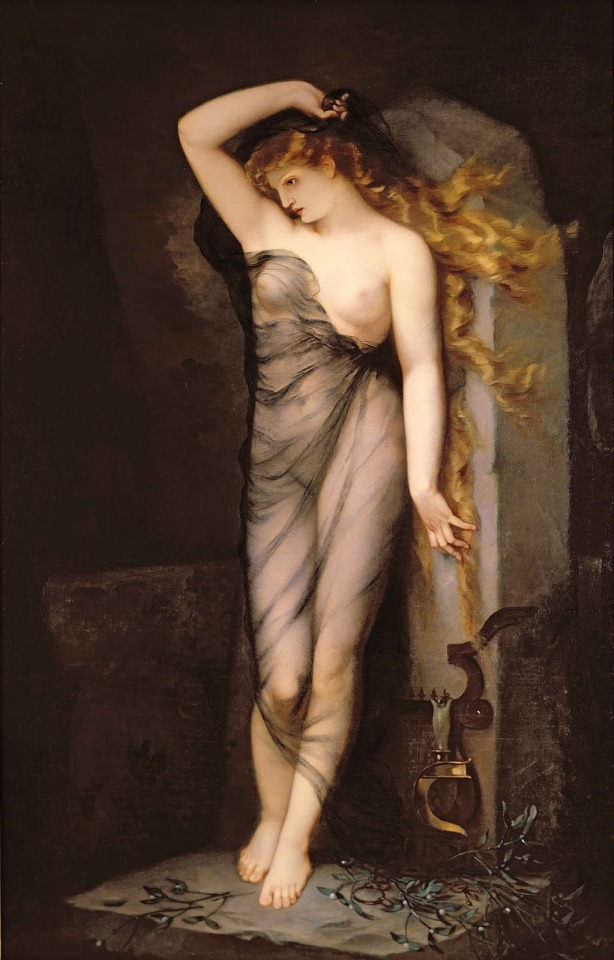
Velleda by Charles Voillemot 1869. Height: 2.3 m (90.5 in); Width: 1.4 m (58.2 in). Museum of Fine Arts of Rennes.
"Time would fail me to tell of thy battles
in the North ; of insurgent Rhine, of captured Veleda's
entreaties and, latest and greatest triumph, Rome placed in
thy hands (to govern) while the destruction of the Dacians
going on, when Gallicus, the chosen, took up the leader-
ship of our great chief, and Fortune marvelled not."
-Silvae of Statius 1.4
https://paganimagevault.blogspot.com/2020/05/velleda-by-charles-voillemot-1869.html
#veleda#the batavian revolt#pagan#europe#paganism#european art#germanic#rennes#museums#german history#roman history#19th century art#classic art#paintings#art#prophet#literature#history#charles voillemot
24 notes
·
View notes
Photo

Isaac van Oosten - Noah leading the animals to the ark -
oil on copper, Height: 69.5 cm (27.3 in); Width: 86.8 cm (34.1 in)
Izaak van Oosten, Isaak van Oosten or Isaac van Oosten (sometimes, due to a repeated typographical error: Izaak van Costen) (10 December 1613 – December 1661) was a Flemish Baroque landscape and cabinet painter active in Antwerp.
Van Oosten specialized in landscape paintings and panels for Antwerp cabinets. His compositions appear to have been popular and incorporate all the elements of the Antwerp school of landscape painting of the first half of the 17th century. He was strongly influenced by other Antwerp landscape painters, in particular Jan Brueghel the Elder, and contemporary Flemish painters such as Alexander Keirincx, Lucas van Uden and Jan Wildens. He was also influenced by the late work of Jan Brueghel the Younger to whom his work is sometimes erroneously ascribed.
His landscapes are simple with open spaces and mostly hilly landscapes typically filled with a pond or road and several clusters of trees. There is an overall sense of gentleness and calm in these compositions. An even, gentle light spreads over the entire painting and the trees are untouched by the wind. He appears generally not to have been influenced by the woodland painters with their preference for dense forest scenes. A number of his landscapes have a Mediterranean flavour. There is no evidence that Van Oosten travelled to Italy and his Italianate landscapes must therefore have been inspired by the work of other painters.
He regularly returned to the themes of The Garden of Eden and the Creation of the Animals, themes that were introduced into Flemish landscape art by Jan Brueghel the Elder. These themes allowed him to show off his skills in painting a variety of animal species – mammals, fish and birds, as well as the imaginary unicorns. He often painted on copper, the smooth surface of which allowed him to arrive at his detailed depictions of flora and fauna.
As was common practice at the time, he often collaborated with painters who specialized in particular scenic elements. Willem van Herp is believed to have painted the staffage in many of van Oosten's works. A good example of such collaboration are the two panels on the Four Elements, on which van Oosten collaborated with Pieter van Avont for the staffage and possibly Jan van Kessel the Elder for the animals and still-life elements.
Works by van Oosten can be found in the collections of the Uffizi, the Museo del Prado, the Hermitage Museum, the Musée des Beaux-Arts d'Orléans, the Museum of Fine Arts of Rennes, the Toledo Museum of Art and other museums.
24 notes
·
View notes
Text

Noël Coypel (1628-1707)
"Resurrection of Christ" (c. 1700)
Oil on canvas
Located in the Musée des Beaux-Arts, Rennes, France
#paintings#art#artwork#religious painting#jesus christ#noël coypel#noel coypel#oil on canvas#fine art#musée des beaux arts#musee#museum#art gallery#rennes france#french artist#christianity#new testament#male figure#resurrection#angel#angels#drapery#red#white#blue#yellow#roman solider#early 1700s#early 18th century#clouds
151 notes
·
View notes
Photo


1794 Christian Marie Colin de la Biochaye - Bad news
(Museum of Fine Arts of Rennes)
302 notes
·
View notes
Text
The path that François Pinault followed

The path that François Pinault followed is worthy of admiration - from a simple worker at his father's sawmill, to a world-famous entrepreneur and art collector. Today, the Pino family's fortune is estimated at billions of dollars. He is one of the few people who had a personal phone number for French President Jacques Chirac. And he, according to rumors, provided comprehensive support to the business person - after all, Francois once saved his life.
Wood business
François Pinault was born on August 21, 1936, in a small French village in the province of Brittany, in the family of a timber merchant. The boy's studies were of little interest. In addition, in college, he was often teased because of his rural accent and peasant origin. At 16, he stopped attending classes and helped his father.
In 1956, François enlisted in the army - uprisings began in Algeria, which was a French colony. In the military service, he earned start-up capital to start his own business, but the money came in handy only after a few years. Two years later, after returning home, Pino, on the recommendation of his father, got a job in a company selling timber.
In 1962, François married Louise Gaultier, daughter of the owner of the company, and soon ran the business himself. The company was renamed the Pinault Company, and they made large financial investments into it, including by Pino himself. However, the marriage did not last long: the couple divorced five years later, although they already had three children - François-Henri, Dominique, and Lawrence. Pino had to pay compensation to the Gaultier family, but he remained with the company.
In the early 70s, he began buying dozens of small firms on the brink of bankruptcy across the country in order to expand his concern. The takeover scheme was simple: he waited for the company's value to fall to a minimum, then bought it. He used the same principle later for market giants.
In those same years, Pino made a deal that brought him impressive profits. He unexpectedly sold his successful company for 25 million francs but kept 20% of the shares. While in the position of CFO, François placed a gigantic order for timber, which caused a real collapse in the market. Material prices plummeted, but to cancel the awful order, the new owners of the company would have to pay an extortionate fine. Since they did not have the named amount, they agreed to sell the Pinault firm for 5 million francs.
And this is not the only example of François Pinault's entrepreneurial ability. In 1974, he predicted or received from reliable sources information about the change in the price of sugar. Pinault invested 300 thousand in the business and earned 10 million francs on it.
Around the same time, François remarried. His chosen one was Maryvonne Campbell, an antique dealer. She introduced the future billionaire to the art world. Pino became interested in this area of investing money and bought world masterpieces of painting.
Abrupt course change
François Pinault's logging business was on its feet when, in 1988, he decided to radically change direction and began investing in various retail companies. He bought a majority stake in several companies: the CFAO distributor in Africa, Conforama home furnishings chain, Printemps department store, La Redoute mail-order store, and books and electronics firm FNA. In 1993, they renamed Pino to Pinault-Printemps-Redoute, and in 2005, PPR.
A year earlier, in 1992, the business owner created the holding company Artémis to manage the investments of the Pino family. They the news magazine Le Point in 1997, Christie's in 1998, and the Ponant cruise line in 2015. Now the holding also controls wine production in Château Latour, Clos de Tart, Domaine d'Eugénie, Château Grillet, Eisele. Another investment Pinault - football club "Rennes", winner of the French Cup: they bought him in 1998.
By the end of the 90s, the luxury industry became the primary interest of Francois Pinault. So, in 1999, Pinault-Printemps-Redoute bought a controlling stake in Gucci Group for $3 billion and Yves Saint Laurent. In 2000, Pinault gained the French jewelry company Boucheron, 2001 - Balenciaga, and the British fashion house Alexander McQueen. In the press, the business owner has even nicknamed the octopus: he bought up any companies and brands that seemed promising to him.
In 2003, the elderly billionaire handed over the management of his companies to his eldest son François-Henri, who is no less famous in business circles. The successor of the family business did not deviate from the planned course and gained the brands Brioni, Girard-Perregaux, and Pomellato. In 2013, PPR changed its name to Kering. The entrepreneur's son is also famous for his marriage to actress Salma Hayek.
Billionaire personality
Joseph Marc Blumenthal described François Pinault as a very tough and domineering leader. For example, after buying another company, he could not hesitate to cut almost all staff, and the first to cut its top managers. In such situations, the interests of business, not people guided solely by the entrepreneur.
Pinault was always very proud of his friendship with French President Jacques Chirac. Back in the 60s, the business person met a junior official, Jacques, and after that, while in prominent government positions, François provided tangible support. So, in 1981, Pinault gained a state-owned timber processing company for only 1 franc. All this is because the entrepreneur dissuaded Chirac from a dangerous trip on the train, which was later blown up by terrorists.
After handing over the management of the companies to his son, François focused on art. Now his collection includes about five thousand works of famous masters - Pablo Picasso, Pete Mondrian, Andy Warhol, and Jeff Koons. However, Pino approaches collecting from the point of view of benefits - investments should bring income. The billionaire even conceived of creating a large museum to house his art collection. The collection will be on display at the Paris Bourse, and the exhibition is scheduled to open in the spring of 2021.
The Pino family is also involved in charity work. In 2019, they allocated 109 million dollars for the restoration of Notre Dame Cathedral after the fire, in 2018 - contributed significantly to the restoration of Victor Hugo's house. Earlier, in 1990, the billionaire took part in the restoration of Burned down French forests, in 2000 he provided financial help to the islands of Brittany, affected by a spill of hazardous substances after the sinking of the oil tanker "Erica".
The figure of François Pinault causes the most controversial rumors in society. On the one hand, he is a successful entrepreneur who built a business empire, although he himself was from a simple peasant family. They say that in order to achieve success, Francois did not disdain dubious and even illegal transactions. In 2020 the Pinault family is ranked 27th on the Forbes list. Her fortune is estimated at $27 billion.
Quotes
"My competitors will either die themselves or I'll eat them."
"My only diploma is a car license."
2 notes
·
View notes
Text
Inside Ancient Egyptian Cat Mummy, Archaeologists Find the Remains of 3 Cats
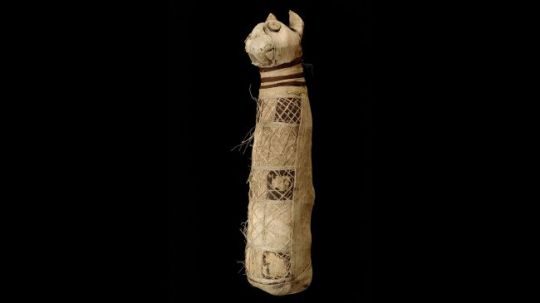
Scans of an ancient cat mummy revealed that the 2,500-year-old feline supposedly resting within the wrappings wasn't a single animal. Instead, the mummy held the partial remains of three cats, according to new findings.
Ancient Egyptian cat mummies aren't uncommon, and archaeologists have previously found tens of cat mummies in burials. In ancient Egypt, pets were commonly buried with their owners. The desire to preserve animals as offerings to the gods led to the establishment of an entire industry and the mummification of over 70 million animals, according to a previous Live Science report.
A group of researchers recently analyzed the 2,500-year-old Egyptian cat mummy that was part of a collection at the Museum of Fine Arts in Rennes, France. The scientists performed a computerized tomography (CT) scan, a type of X-ray, to illuminate what was inside the mummy without unwrapping it, and then they created 3D digital and transparent 3D-printed reconstructions of the mummy. Read more.
268 notes
·
View notes
Photo
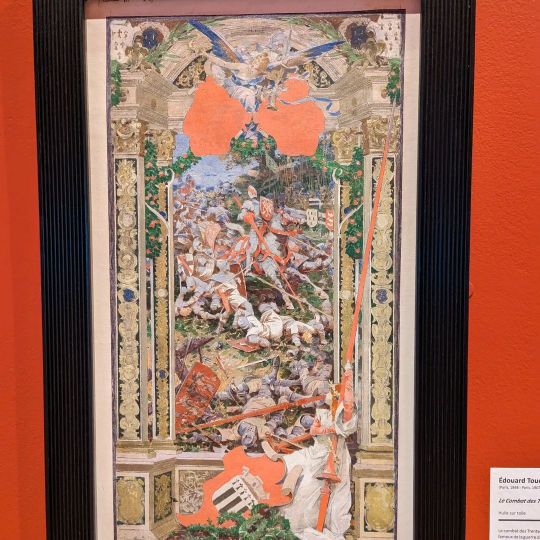
The Death of Du Guesclin by Édouard Toudouze. Rennes Museum of Fine Arts. Forgotten hangings from the Parliament of Brittany are making a comeback in Rennes. In spare parts. They adorned the Great Chamber of Parliament until 1994, the year of the famous fire that ravaged the building. #dugueslin #finearts #rennes #parliament #brittany (à Musée des Beaux-Arts de Rennes) https://www.instagram.com/p/CoeOW13I8F0/?igshid=NGJjMDIxMWI=
0 notes
Photo
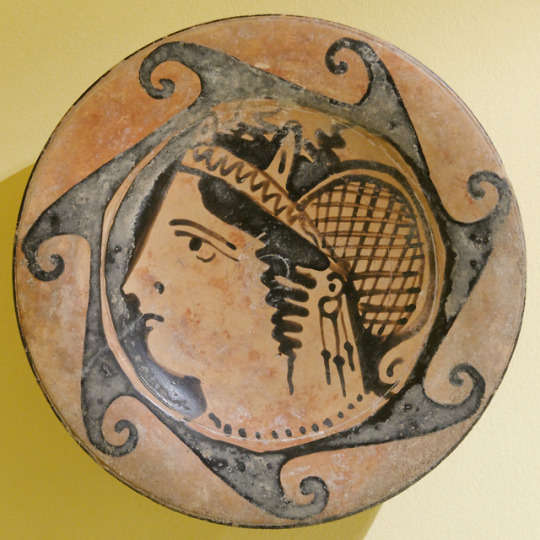
The head of a woman. Tondo of an Etruscan plate, variously attributed to the Genucilia Group or the Ostia Genucilia Painter; ca. 350-300 BCE. Now in the Musée des beaux-arts de Rennes, France. Photo credit: © Marie-Lan Nguyen / Wikimedia Commons / CC-BY 2.5.
#classics#tagamemnon#Etruria#Etruscan#Ancient Greece#Hellenistic period#art#art history#ancient art#Hellenistic art#Etruscan art#red-figure#plate#tondo#ceramics#vase painting#Genucilia Group#Ostia Genucilia Painter#Musee des beaux-arts de Rennes#Museum of Fine Arts of Rennes
312 notes
·
View notes
Text
Vermeer
Inside my copy of Ludwig Goldsheider's Phaidon Press Vermeer I wrote my name and the date of purchase, 1958. I was then fourteen years old. The battered volume is a record, therefore, of an attraction to this artist that stretches back to childhood. Not unnaturally I would like to find a way to acknowledge all that he has meant to me over the intervening years. I have no gift to write of his art like Lawrence Gowing - still less like Proust - but in any case my preference is to use connoisseurship to extend, if possible, our understanding of his oeuvre by seeing if there are viable addenda that can be appended to it; and that is the main purpose of this Study. A secondary aim is to draw attention to the dangers involved in 'cleaning' what we already have. By way of caveat I urge any readers I may have not to expect everything adduced to look like their idea of 'a Vermeer'. Connoisseurship has to allow for development. An early Cézanne does not look much like a late one.

To begin at the beginning of Vermeer's career as a painter is chronologically proper but somewhat frustrating because we know that he is farthest from where he needs to be and where we wish him to be. Through his and his father's picture-dealing he comes into contact with Italian paintings of a religious and mythological nature which encourage him to try his hand in a similar vein. What survives of this derivative, experimental period is the St Praxedis - his version of a composition by a Florentine artist Felice Ficherelli - and the Diana and her Companions.
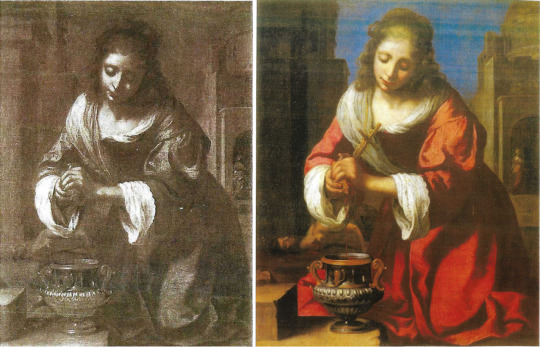
St Praxedis by Ficherelli (left) and Vermeer’s copy (right)
Being by Vermeer, these are not bad pictures; indeed the St Praxedis is that rare thing, a copy better than its original. In both works there is a fluency of brushwork, a Baroque rhythm, and a palette that at this stage includes a yellow, a deep blue, a winey brown, and a rose red that, mixed with white, becomes a violet.
I can only suggest one work to add to this early phase of Vermeer's oeuvre and that is a picture of the head and shoulders of a rosy-cheeked girl.

Portrait of a Girl by De Bray (left) and detail of St Praxedis (right)
When it passed through the hands of a London dealer (Chaucer Fine Arts) in 1989 it was attributed, not very accurately, to Jan de Bray. The face is painted in a style hard to reconcile with any of the young female faces in later Vermeer, but it does seem close to that of St Praxedis and to the facial types in the Diana picture. Common to all of them are the rose-white-violet juxtaposition, the swirling drapery and soft sfumato.

Christ at the House of Mary and Martha (National Gallery Scotland)
With the large ‘Christ in the house of Mary and Martha’ at Edinburgh we may be moving backwards rather than forwards chronologically, but Vermeer seems recognizably more Vermeerish. He is still in his broad-brush Religion and Myth phase but the religion is as domesticated as it can be in that story of Mary and Martha, so one feels that he is moving towards the territory that he will make his own. Even in the earliest pictures it is noticeable how women predominate as we know that they will in the future. On the relative merits of Mary’s life and Martha’s, Vermeer's art is, and remains, tacitly neutral: it pays tribute to both. As if to illustrate this there is a study in watercolour for the figure of Mary, and a drawing that is not for the figure of Martha (being stylistically later) but certainly alludes to her servant role.
In the Printroom at Leipzig is a remarkable wash drawing which Bernhard Degenhart included in an anthology of European drawings (Europaisches Handzeichnungen) published at Dresden in 1943 as the work of the landscapist Jan Siberechts.
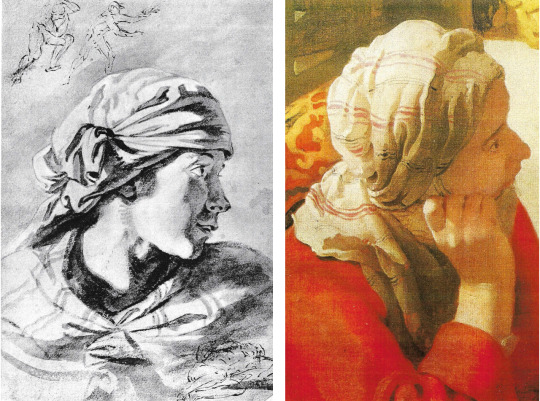
Drawing attributed to Siberechts (Leipzig) and detail of Martha
That attribution can be dismissed because there is nothing in Siberechts to support it beyond the flimsy fact of there being a landscape drawing on the verso. The little pen sketches of figures at the top and lower right of the sheet are by another artist; disregarding those, I think that there is a strong possibility that what we have here is a study by Vermeer for the figure of Mary in the Edinburgh picture; there the listening head is swivelled a little further round towards Christ. The light in consequence falls differently, but otherwise the similarities are close: there is the same profile with slightly parted lips, the same headcloth with the same striped pattern on it, and the same bright lighting from our left if we allow for the turn of her head.
It is the dramatic lighting, with maximum contrast in the folds of drapery and in the face too, not of Mary in the picture (now in shadow) but of Martha, that most accosts me. I notice as well the jugular vein in the neck of Christ. The wash is applied quickly but with complete assurance. The shadowed area of the face is conveyed in a manner that looks forward to the shadowed halves of the two heads in Washington, the Girl with a Red Hat and the Girl with a Flute.

Girl with a Red Hat (left) and Girl with a Flute (right) (National Gallery Washington)
The strange wavy border that the bright light creates on her cheek, from the near edge of her eye down to her chin is typical of Vermeer’s observation of light, how it produces form, without line, in the most surprising ways. In this respect the Leipzig drawing seems more advanced and prophetic of his future powers than the painting.
The Leipzig drawing, as we have seen, is scarcely a drawing in the linear sense at all, but at Besançon there is a sketch of a more conventional kind. In what becomes his favoured graphic medium - black chalk heightened with white on blue paper - it shows a servant holding a shallow circular basket or tray.

Woman with Tray signed ‘De Hoogh’ (De Hooch)
She is probably not a study for Martha, but one can see the folds of her sleeve following the pattern of light and shadow that is distinctive at Edinburgh in the sleeves of all three participants but more particularly on Christ’s outstretched arm. Her face has the signature oval shape and high-arched brows.
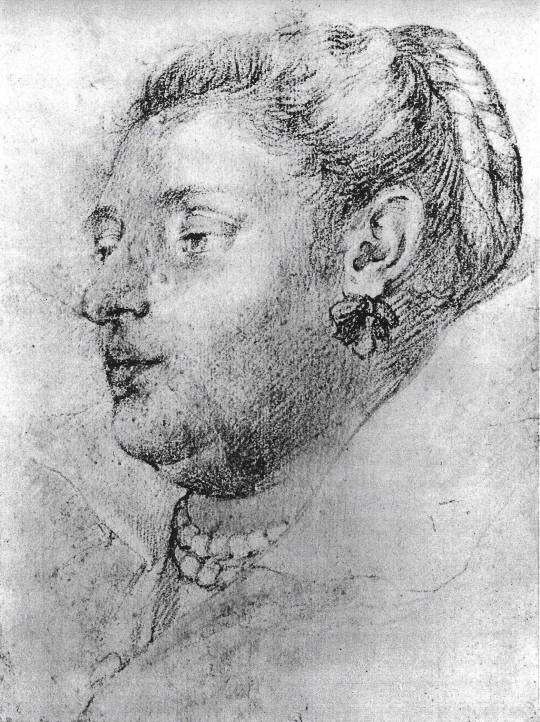
Portrait of a Lady (Royal Collection Windsor)
A third drawing may still be quite early but marks a change to something less loose, less generic, much more personal. This is in the Royal Collection at Windsor, a ‘Portrait of a Lady, Anonymous, Flemish school 91/2 x 7in, black chalk on white paper with red chalk for the flesh and the necklace of pearls’. The cataloguist comments that it is the ‘work of a follower of Rubens lacking peculiar characteristics’. If we stop thinking about Rubens, perhaps its characteristics will start to seem more peculiar, and peculiar, I suggest, to Vermeer. It is likely to be later in date than the Edinburgh picture, but the similarity of facial features if we compare the profile of this middle-aged woman with that of Christ is, for me, compelling.
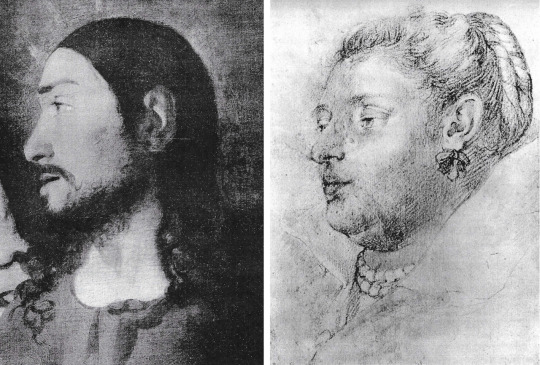
Detail of Christ at the House of Mary and Martha (left) and Portrait of a Lady (right)
It cannot be proven but my hunch is that this tender portrait is of Catarina Bolnes, Vermeer’s wife, bearer of their many children, and also likely model for the painting at Amsterdam of the pregnant Woman in Blue reading a Letter.

Woman in Blue and detail of face (Rijksmuseum)
Placing her tête-a-tête with Christ and putting aside the double chin so truthfully recorded, notice the mouth, the cupid’s bow upper lip and projecting lower, the depth of the upper eyelid, and the straight nose that nevertheless marks where the bone ends and softness begins. As for ribbons and pearls, they are fashion accessories worn by women in the paintings of other Dutch artists, so their presence in this drawing can only be corroborative evidence; still, we know from later paintings by Vermeer how much he liked his family members to sit or stand for him wearing these adornments, particularly pearls because they represented drops of light.
Whether or not I am right about Catarina, this sensitive, fairly rapid sketch does demonstrate that Vermeer needed to make drawings of his models. The camera oscura was invaluable for helping to accurately determine how furniture and figures are disposed within a chosen perspective, but that tool does not solve everything and I always thought it probable that for the faces at least he would have made some preliminary studies in chalk or oil paint on paper, even if no such drawings survived. Fortunately, as already suggested, a few have, and this is a particularly beautiful example.
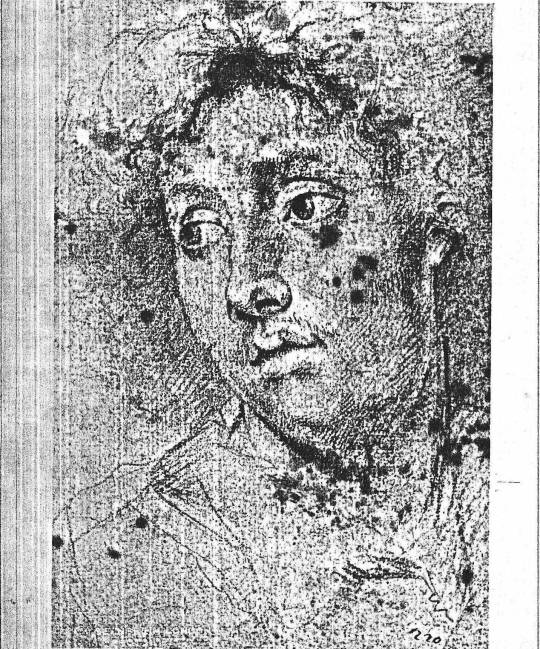
Portrait of a Young Man - Anonymous
At Rennes in France there is another close-up drawing, of a youngish man's face, his eyes directed down to our left as we look up. This is texturally very similar to the Windsor drawing, but it more particularly demonstrates three features found in the paintings. One is the drawing of the eyes, the almond shape of the eye itself, the broad strap of upper lid, and the elevated brow. This is famously clear in the Girl with a Pearl Earring at the Mauritshuis, but also in the Kenwood Girl with a Guitar, the Wrightsman Study of a Young Woman (Metropolitan Museum NY) and the two close-ups at Washington, Girl with a Red Hat and Girl with a Flute.

Details clockwise from top left: Girl with a Pearl Earring, Study of a Young Woman, Girl with a Guitar, Portrait of a Young Man, Girl with a Red Hat, Girl with a Flute
A second feature is the lips being parted, as in several of the works just cited. A third is the generous oval or elliptical shape of the face as a whole, which is the result of underplaying the chin and cheekbones.

Studienkopf - Study of a Boy’s Head, attributed to Vermeer
‘Oil paint on paper’ and the above remarks about oval faces are a cue to insert here a small study of a face in that medium that is in the Berlin Printroom. This has long been attributed to Vermeer, not by all but by many scholars from 1907 onwards. It bears all the signs of being by his hand and, besides being a fine and precious thing in itself, is a helpful link to other things. Notice, again, the shape of face that is different from what we find in other artists’ work, the mouth with its wavy upper and sensuous lower lip, a certain relationship and distance between eyebrow and eye, and of course the light that shapes everything. Whether this is an abandoned self-portrait no one can say for sure, but it could be. If one looks hard at oneself in a mirror, the eyes do narrow and squint a little, producing the fixed ‘tunnel’ gaze that this face returns to us so straightly and directly while giving, it must be said, nothing away (but what else would one expect of Vermeer?).

Singender Jüngling - no attribution
From Berlin to Vienna now, and from oil on paper to oil on oak: a small panel in the Kunsthistorisches Museum. This is of a young man singing (Singender Jüngling). The piece of paper he is holding does seem to be a sheet of music and as he is turned towards us with his mouth open he is probably singing, not talking to us about a letter. In any case what matters is that a living moment is caught in a turn of attention with a turn of the head, and thereby temporally and pictorially stopped for ever, as happens over and over in Vermeer. Is this picture by Vermeer? I offer it for consideration. If it is, it is not classic mature Vermeer, nor on the other hand is it very early. I would place it close to the Boston Concert (now sadly missing), the Frick ‘Girl Interrupted At Her Music’, the Metropolitan’s Servant Asleep. It is smaller than any of them, only 91/4 x 71/4 inches, the size, roughly, of the Louvre Lace Maker or the two Washington Girls.

The Concert (stolen)

Girl Interrupted at her Music (Frick)

Servant Asleep at a Table (Metropolitan Museum)
At this point the Berlin oil study on paper provides a helpful comparison: for the shape of the face and of the eyes, the form of the lips (albeit closed in Berlin) and for the lighting if one imagines the face at Vienna upright, not tilted, and facing us straight on.
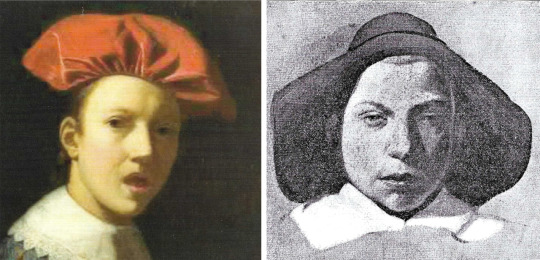
Detail of Singender Jüngling (left) and Studienkopf (right)
As for the palette the wine-dark brown mantle over the Singing Boy’s right arm reminds us of the colours in the dress of the Sleeping Servant and of the companion of Diana who sponges her foot.

Details of Servant Asleep (top) Singender Jüngling (btm left) and Diana’s servant (btm right)
From surviving images of the Boston Concert, we can not be certain but it seems likely that boy's orange ‘beret’ may be comparable with the chairback of that missing artwork.

Orange beret from Singender Jüngling (left) Chair-back from The Concert (right)
Lighting here is from a source to our left, but Vermeer – if it is he - is not yet committed fully to daylight; the boy is lit within an ambient darkness, much as in a Caravaggio or any number of portraits. The other thing to notice is the way the boy is holding the paper with both hands. One might think that numerous Dutch pictures would show hands in a similar position, but it does not appear that this is so; it is, however, a gesture that recurs in Vermeer, in the Lady in Blue at Amsterdam, the Girl Interrupted at he Music in the Frick, in the Dresden Girl Reading a Letter at an Open Window and, we shall see, in another putative Vermeer.


Details from Singender Jüngling (top), Woman in Blue (left), Girl Reading a Letter at an Open Window (centre) and Girl Interrupted at her Music (right)
With the Vienna Singing Youth we are, as noted, not out of dark and into sunlight; we are by no visible window and the light has no sparkle. We are in an enclosed world like that of the tavern or the brothel, the venue of the Procuress at Dresden where what light there is, golden and silent amid the muted voices, seems to move surreptitiously, illuminating part of a collar, a bit of wall, a patch of rug before landing in a blaze on a yellow jacket, a scarlet jerkin, a binary echoed in the carpet.
Here is another large early work, disconcertingly different from what precedes and what follows it. The oil medium is drier here and carefully applied with no broad-brush bravura, no squiggles of highlight. Where in the future it is light that will seem liquid, poured into a room as into a tank, here it is shadow that spreads downward, drowning much of the left side of the picture, all but hiding faces, turning the folds of the carpet into dark ravines, and generally claiming the territory. Here is an artist revealing himself, for now, to be potentially as great a poet of shadow as he will be of light; one is readily reminded of Caravaggio’s Calling of Matthew in Rome.
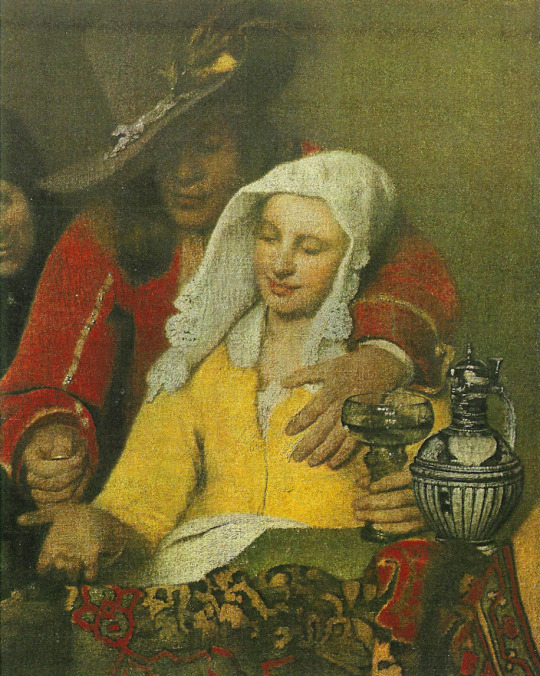
Detail from The Procuress
If we are to find anything to accompany the Procuress in this possibly short-lived stage in Vermeer's development, it must exhibit that dry handling of paint that we see in the depiction of the woman and her client. Again what I offer is a suggestion appended to a sad admission in this case that I have no idea where the picture is. It is a portrait known to me only as an old photo placed among other portraits that have been attributed at some time or another to Velasquez. It is at any rate not by him. It once belonged to a Mr A. W. Leatham.
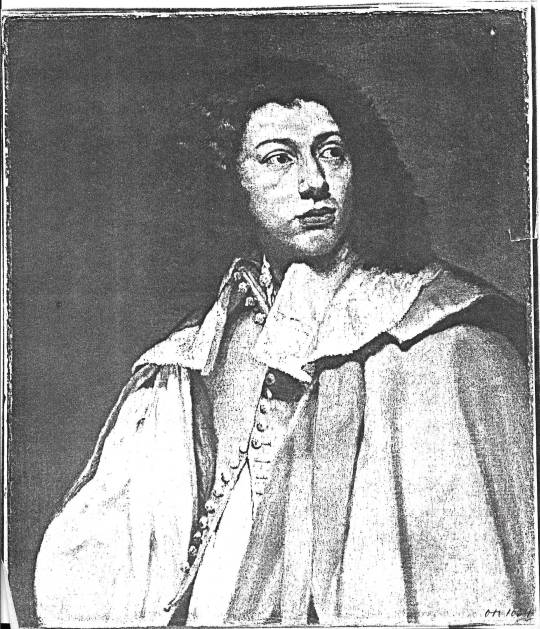
Portrait - attribution and whereabouts unknown
Here we clearly see, even in a photo, the dryness; but what lends credence to a Vermeer attribution is the face when one compares it with that of the Berlin oil study: within the same generous oval are the same eyebrows, nose and lips; the eyes in the Leatham picture are much more open but otherwise compatible. If this were to be Vermeer's it would be our only independent painted portrait - of whom we may never know.

Maidservant Warming Her Feet - attributed to Vermeer
In the volume referred to at the top of this essay, the 1958 Phaidon Vermeer by Ludwig Goldscheider, there is one drawing included among the main body of plates, a drawing therefore that Goldscheider clearly thought was definitely by Vermeer. It had been published once before, by H Leporini in 1925, but Goldscheider helpfully reproduces it in its actual size. He calls it Maidservant warming her Feet; the original is in the museum at Weimar. The monochrome reproduction gives one a good idea of the soft graininess of the black chalk finely hatched in strokes that run at right angles to the pose of the seated servant. What cannot be seen are the touches of red chalk added to neck and forearm (much as in the Windsor drawing) or the white heightening that in a photo looks deceptively like the white of the paper though the paper in reality is blue.
Why is this beautiful drawing omitted from subsequent books on Vermeer? Could it be that scholars are sceptical on account of the artist’s monogram V M drawn on the side on the footwarmer? One can agree that this is unusual, but that by itself should not be ground for exclusion; genius can be allowed some eccentricity, and anyway it is not too difficult to imagine that this very finished and presentable drawing was in fact presented to someone, possibly the model for it, and that the monogram was added as a mark of the special occasion or as a token of gratitude or to pay a debt. Nobody suggests that it is an outright fake from a later century, so it has to be of Vermeer's time and I question whether any contemporary could produce a drawing of this quality and of this kind - a drawing where form is defined so consistently by light. This is Vermeer's photographic vision, as it would be Seurat’s in a later age.
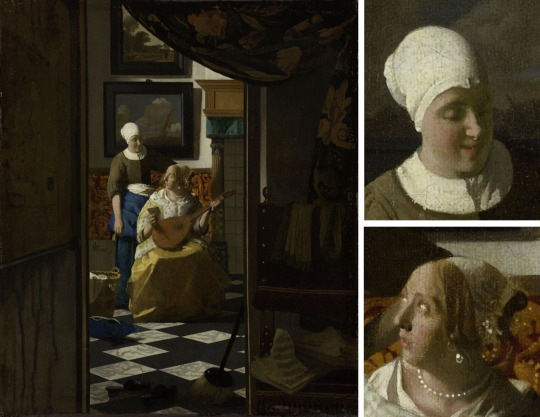
The Love Letter - Vermeer’s use of light is comparable to Maidservant Warming Her Feet
The sitter, besides: is surely the family's stalwart servant, Tanneke, the same who pours milk and delivers a letter (in two paintings) and maybe holds a jug as she opens a window.

Details from The Love Letter and Milkmaid for which Vermeer used his maid Tanneke as a model
The date of the drawing is anyone's guess, but it clearly belongs in the period of the great cameral pictures. Another drawing, of unknown whereabouts and less remarkable is of similar facture and shows a servant asleep.

Drawing of a Servant Asleep - unknown
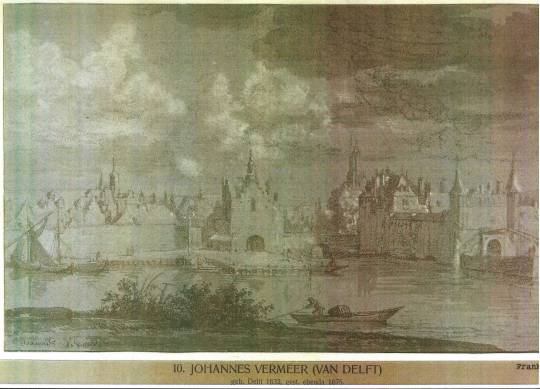
View of Delft by Moonlight - attributed to Vermeer
Scepticism regarding the Weimar drawing seems to have led to doubting generally that any extant drawing is by Vermeer. This is a pity because there is much to be learned from his draughtsmanship. Take this drawing at Frankfurt, a supposed copy of the famous View of Delft from across the canal to the south of the town.

The Original ‘View of Delft’ by Vermeer
Why would a copyist take such liberties with what he is copying from? Why alter the arrangements of the buildings, omit barges, totally change the sky and foreground, remove figures and substitute fishermen in boats? He would be a remarkably inventive copyist who did all that! How much more likely that this is a drawing Vermeer made in situ on a day when there was a busy sky with rain-threatening cloud but with sun behind him that lit the south-facing walls, towers and spires of the town. The painting in the Mauritshuis, like a large ‘Academy’ Constable, is the outcome of onsite visits and studies all of which contributed to his decision-making, but none of which was exclusively determining.

It is very believable that a painter with Vermeer's temperament, seeking always a calm resolution, would not in the end choose a hectic cloudscape, would want to clear the foreground of weeds and bushes, would reject as picturesque a man in a boat who distracts attention from the town across the water, and would decide that the town could not cohere if too many surfaces were lit at the same time across the whole piece. Instead, as we can see in his final consummation, he creates a series of long horizontals from the left, lowers the red- tiled roofline, extends the town wall and the quay, and emphasises all of this with a long placid reflection in the water.
The gap in the reflections comes where the two southern gates of the town connect at the bridge, and that is where he chooses to have the sunlight begin to illumine, not the immediate edge of the town but the buildings beyond and within it; this illumination then continues, ducking and weaving, to the limit of the picture on our right. It can therefore be said to be an outdoor view with an interior, of the town, lit from the right, as only the Lacemaker is among his indoor pictures.
Something curious about the painting vis-a-vis the drawing is the effect created by clearing the foreground of everything except very small figures that lead our eye from a point directly under the reflected left tower of the Rotterdam Gate, across the deserted sandy back to the two women talking, and thence to the group waiting for the ferry at the far left. Vermeer has radically revised in a way that manages to make the town as a whole seem nearer than the foreground figures but as calm and reflective as any of his single figures in a room. At the same time he has concentrated the light in the right half of the picture and given it a warmth to match the pale ochreous emptiness of the foreground that starts from the left, dies towards the right.
Old reproductions of this extraordinary painting show that the cloudscape was perhaps once much more modelled and interesting than it now is. As too often happens, there has been a flattening, a loss of density and volume in clouds that Vermeer knew to have both.
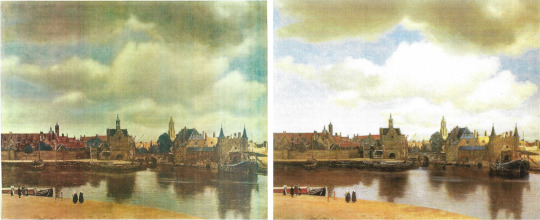
Vermeer’s painting before (left) and after (right) cleaning
If the drawing is original, then it tells us that Vermeer was no different from Ruysdael, Jan van der Cappelle or any of his country's great skyscapists in his understanding that clouds have a superstructure and an undercarriage and as such constitute a sort of moving architecture as they build, dissolve, and build again - a match for earthly buildings shaped by light.

Painting of Maid and Child - attribution and location unknown
The same lesson may be learned from the last item I can offer which, like the Leatham portrait, I know only from a photograph. I do not know its whereabouts or even whether it exists. Coming across the photo lying among unattributed Dutch paintings was nevertheless a memorable moment because I connected the image at once with Vermeer, specifically with his family’s servant, Tanneke, she of The Milkmaid, sitting in her place in the kitchen with a letter held between her hands - in that now familiar position - as she turns aside to attend to a child with a bowl. It seemed clear that the original, of which this may be the only record, was unfinished, abandoned by the artist for whatever reason.
If the original was indeed by Vermeer, then it would be unique among his known works in being a composition with a child in it. Why are there no children in Vermeer's paintings? Did he exclude them because they were too excitable, would never stay still? Did he exclude the elderly because they reminded him of the nearness of death, the fate of too many children of his time, including some of his own? In this case a child does get included, but how securely? Did the artist have doubts? If he took the child out, it would leave the servant looking down to our right for no obvious reason. Her pose is towards our left but her attention is to our right. If the child stays, the chiasm demands something - a small window - in the upper left corner.
Such is the rationale of the image as a composition, but the photo also suggested something about the original’s texture and lighting, factors which go together. What I particularly noticed and was excited by were incipient signs of those lovely beads of light so uniquely characteristic of Vermeer's art.
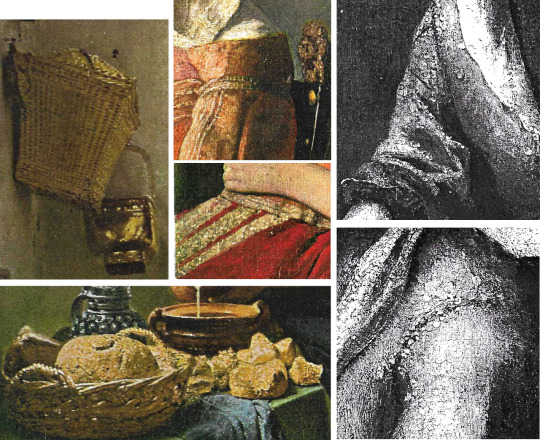
Details of painting techniques in The Milkmaid (left) and The Glass of Wine (centre) which could be compared with the portrait of Maid and Child
I had supposed that they were last touches, yet the photo appears to make them part of the earlier planning of a picture, prefigured elements in his vision of a scene. If the original ever turned up, we could be satisfied about these technical mysteries.
For myself, I am not sure that I want or need to know how Vermeer painted his pictures; I am reasonably content to marvel at the mysteries and credit them to genius. However, in view of the damage, as I see it, done by conservators to some of the Vermeers that we have in our museums the above old photo from 1947, of a lost picture that passed through the hands of a dealer called Katz, is valuable evidence that from the start of a painting Vermeer knew that what he wanted to record was light, and that light falls in a logical way which creates, according to the time of day, profound areas of shadow that can abut the light with little or no gradation.

Above are two photos using natural light and shadow (left and right) Detail from Lady Writing a Letter with her Maid (centre)
This is most true on a sunny day in the morning, less true by early afternoon. The contrast, clearly visible in the photo, between the lit and shadowed side of a sleeve is extreme. We all know this because we all live in the age of photography, the age that began just before Vermeer started to be rediscovered. Unfortunately for his paintings - and certainly not only his - we also inherit the preoccupations of the twentieth century which to a large extent revolved around the picture plane and its flatness. Combine flatness with iconography, another leading concern, and you get a visual sensibility that finds the pattern on a carpet more important to clarify than the logic of the light which would keep it dark. Here are two photos to illustrate (in the original sense of the word) the contrast that must be respected.
I am not a conservator. Even the thought of surgical intervention in the surface of a Vermeer makes me nervous; but if intervention is ever necessary I think two rules must apply: always respect the logic of the light, and never, if you can help it, reveal the canvas or other support. Vermeer's art is one of illusion, a very poetic and light-sensitive version of trompe l'oeil. Expose the canvas and you destroy the illusion; a wall ceases to ‘be’ a wall and becomes what it mostly is in de Hooch, a bit of brushwork pushed around over a bit of stretched cloth.
In conclusion I hope it is clear that drawings and even old photos can tell us important things about the essential nature of an artist's vision, the imagination that shapes images, in Vermeer's case through light and light’s dark accomplice. Having opened this essay testifying to my own long admiration for the art of Vermeer, I can best end it on a similar note but in the context of Delft. A painter called Cornelis de Man lived there at the same time as Vermeer and painted some pictures of domestic interiors that are testimony to his own admiration for those of Vermeer, a fellow-townsman and Guild member whom he personally knew.

Still Life with Lute and a Jug - De Man
The picture of Vermeer that is now at Miami (and which was later engraved) is by this artist and very much in the Vermeer manner though crude and inferior by comparison.
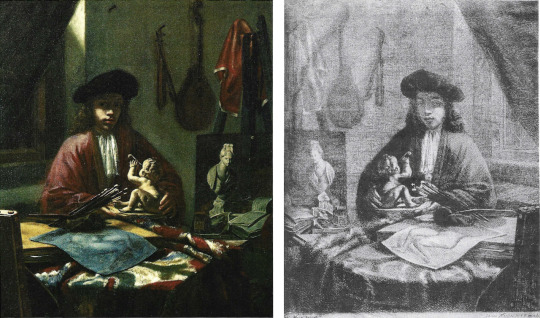
Portrait of Vermeer by De Man (left) and engraving thereof (right)
Also by this artist is a far better and more finished picture at Polesden Lacy near Dorking.

The Game of Cards - De Man
It shows a middle-aged man facing a young woman over a table where they are playing cards. A young child to the right who stands hardly higher than the table on which one hand rests looks out of the picture to direct, perhaps, another child's attention to the grown-up’s game. The young woman looks round towards us as one might turn to a camera.

Details from De Man’s Portrait of Vermeer and The Game of Cards
Comparing the face of the man with that of the painter in the Miami picture, I think it very probable that we are looking at Vermeer himself relaxing opposite one of his daughters, with another of his many children beside him. The picture can stand in any case as a pleasant memorial to that genius of a ‘family man’, celebrant of town, home, kin and friends, who was happy to include those closest to him in what are still, despite the cleanings, some of the greatest of all representational paintings.
Julian Pritchard
March 2017
#vermeer#art history#dutch painter#flemish school#art theory#painting techniques#stolen art#frick museum#metropolitan museum of art#kenwood house#cornelis de man#girl with a pearl earring#connoisseurship
4 notes
·
View notes